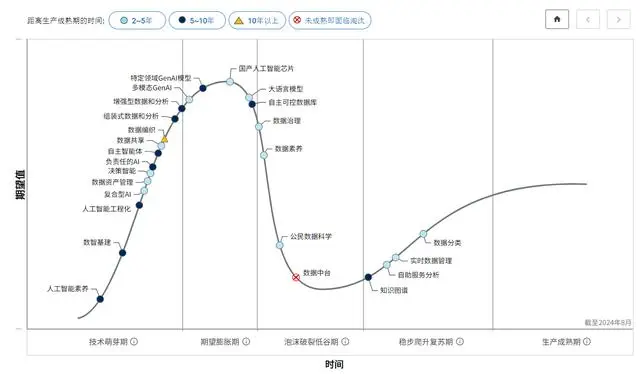Gartner recently released the latest 2024 China Security Technology Maturity Curve, which introduces innovation in China's security field. This year, two new innovations have been added: AI Network Security Assistant and Security Information and Event Management (SIEM). At the same time, China's privacy protection technology has reached an expected period of expansion, due to the constantly changing regulatory framework and China's desire to lead the development and adoption of AI technology.

Gartner's Senior Research Director, Gao Feng, stated that "adopting disruptive technologies such as Generative Artificial Intelligence (GenAI) requires increased investment in security, while Chinese enterprises are still constrained by budget. At the same time, enterprises are also investing in digital innovations such as GenAI. These digital investments bring new attacks and may require new security protection mechanisms. Therefore, enterprises need to optimize security measures to balance the adoption of new technologies and budget constraints
Privacy Protection in China
The Personal Information Protection Law of the Republic of China has greatly changed the legal and regulatory landscape in China, providing a broader framework for the protection of personal data of Chinese citizens and imposing severe punishment measures. The regulatory framework in China is similar to the principles stipulated in other regional laws, but companies should carefully study the complex requirements related to data localization, data authorization principles, and cross-border data transmission, and respond to these requirements in their privacy policies.

Security Services Edge (SSE)
Chinese SSE products integrate different security features (with less integration of secure web gateway [SWG] and zero trust network access [ZTNA]), reducing complexity and improving user experience through additional software as a service (SaaS) security features. This type of product is delivered locally or in the cloud. SSE allows enterprise organizations to implement security policies in web, cloud services, and private application access, providing support to employees anytime, anywhere. At the same time, SSE reduces the management complexity of operating multiple products, allowing for clearer visualization of end-user operations across multiple platforms.
IoT authentication
Internet of Things (IoT) authentication refers to the mechanism by which a single object (usually a device) establishes trust for its identity when interacting with entities such as devices, applications, cloud services, or gateways operating in the IoT environment. With the explosive growth of the Internet of Things market, these interconnected devices can connect networks and the physical world, but they can also trigger new attack threats. A comprehensive IoT security requires IoT devices with strong IoT authentication capabilities to mitigate and minimize risks and/or other issues and vulnerabilities.
AI Network Security Assistant
Artificial intelligence (AI) network security assistants utilize big language models to uncover existing knowledge provided by network security tools and produce content related to target roles in the security team. AI network security assistants are mostly used as auxiliary functions for existing products, but can also serve as dedicated front-end or take action through integrated software intelligent agents. These AI network security assistants can discover knowledge and create content (usually in the form of summaries or production code/scripts), which has attracted the attention of network security executives for its potential to improve productivity. These assistants may evolve into more autonomous agents that can work based on general instructions without frequent prompts.
Security Information and Event Management (SIEM)
Security Information and Event Management (SIEM) is a configurable security record system designed to aggregate and analyze security event data from both local and cloud environments. SIEM can assist relevant personnel in taking response measures to reduce the negative impact of events on the enterprise organization, while supporting compliance and reporting requirements. One of the key elements for effective implementation of security projects is to summarize and standardize security data, and visually display the security status of the enterprise organization. SIEM can support security operations centers to identify, prioritize, and investigate security incidents. Widespread visibility is the foundation for making decisions in daily security operations.
Several innovative technologies related to AI

Composite AI
Composite AI refers to the combination (or fusion) of different AI technologies to improve learning efficiency and generate knowledge representations with richer levels. Composite AI provides richer AI abstraction mechanisms and ultimately offers a platform that can solve a wider range of business problems in a more effective manner. Composite AI can bring two major benefits to Chinese enterprises. Firstly, extend the power of AI to enterprises and institutions that are unable to access large amounts of historical or labeled data but possess extensive human expertise. Secondly, expanding the scope of AI applications and improving the quality of such applications also means being able to tackle more types of reasoning challenges. According to the specific technology applied, a series of other benefits can also be generated, including improved interpretability, resilience, and support for enhanced intelligence.
Domestic AI chips
Due to restrictions imposed by the United States on high-performance AI chips, Chinese companies have had to independently develop AI chips to meet their own rapidly developing AI needs.
The latest Generative Artificial Intelligence (GenAI) technology requires the use of thousands of AI accelerators to train base models and support inference workloads. Due to limitations in advanced manufacturing processes, the performance of domestically produced AI chips lags behind that of products from leading global suppliers. Therefore, Chinese companies need to invest more in AI infrastructure. IT leaders should focus on AI applications rather than using domestically produced AI chips optimized for inference workloads to train basic models.
LLM
The Large Language Model (LLM) is an AI foundational model trained on a large amount of unlabeled text data. With the help of big language models, applications can complete a series of tasks, including answering questions, content generation, content summarization, retrieval augmentation generation (RAG), code generation, language translation, and conversational chat.
This type of model has a wide range of application scenarios, including text generation, question answering system construction, document summarization and classification, text translation and editing, etc.
Multimodal GenAI
Multimodal Generative Artificial Intelligence (GenAI) can combine and utilize various types of data inputs and outputs in generative models, such as images, videos, audio, text, and numerical data. The multimodal function allows the model to interact with outputs from different modalities and generate corresponding outputs, effectively improving the usability of GenAI.
Multimodal GenAI supports the addition of new features and functionalities that were previously difficult to implement, which will have a disruptive impact on enterprise applications. At present, multimodal models are usually limited to two or three modalities, but in the coming years, more modalities will be covered.

